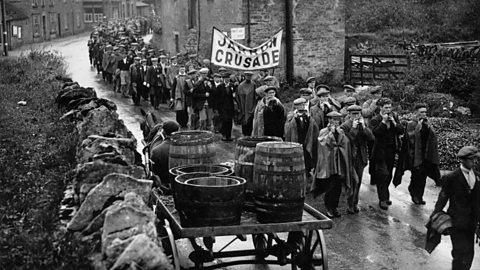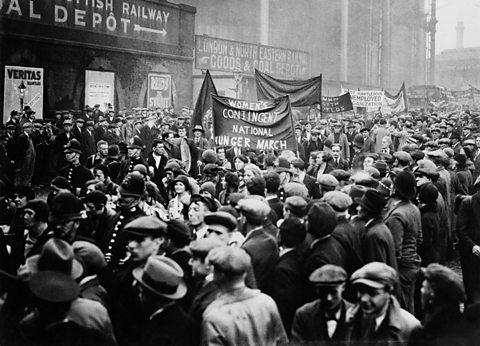Hunger marches
Jarrow
In 1936, the people of Jarrow, a town in north-east England, were desperate and organised a meeting with a Cabinet minister to seek help. Unfortunately, they were told to go home and work out their own salvation.
To gain publicity for their cause, the people of Jarrow organised a non-political march to London. 200 men, in their Sunday best, led by the Mayor of Jarrow, the MP Ellen Wilkinson and some town councillors, marched peacefully in step for over 450 km.
They were looked after in parish halls and gained great support along the way. However, there was little support from the government when, after eight months, they reached London and the Prime Minister, Stanley Baldwin, simply ignored the petition.
Sadly, the people who had marched were told their dole payments were reduced due to the fact that they had made themselves unavailable to work during the time they were marching.

Rhondda
There were also a number of hunger marches which involved people from the Rhondda Valleys and other areas of south Wales.
- Autumn 1927 - Two years before the Wall Street Crash, the Rhondda was already struggling with high poverty levels. On Sunday 18 September, a meeting named the 'Red Sunday in Rhondda' called for a march to London to raise awareness of the economic difficulties. Due to disagreements between different organisations the march never took place. The planned march highlighted both the poverty in the Rhondda, and the feeling that politicians in London did not understand the area.
- 5 September 1931 - 112 people, including 12 women, took part in a march to Bristol, with a third of the marchers from the Rhondda. Under the slogan 'Struggle or Starve', the march was broken up by the police in Bristol.
- 14 October 1932 – there was a nationwide hunger march to London. 2,500 marchers from all over Britain participated, including 375 from south Wales.
National Hunger March, 1932

In October 1932, 2,500 workers from across the country participated in a march on London. Trade unionists helped organise the march and arranged food and shelter for the marchers.
The marches worried the government who made sure there was a significant police presence, and deployed spies to infiltrate groups. Force was also used in some cases to confiscate petitions to prevent them reaching parliament.
The last march in October 1936 had the backing of the Labour party and 504 marchers. However, like those before it, it achieved little.